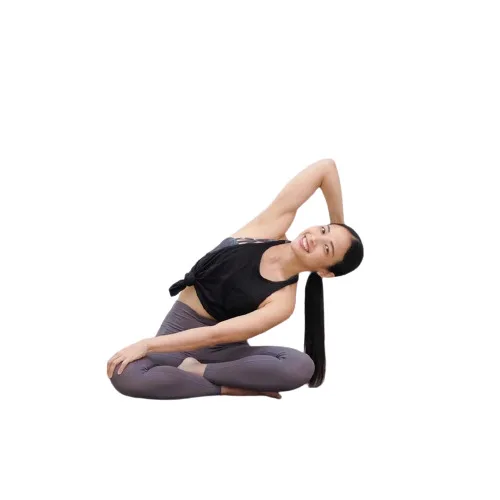Are you one of the many people who suffer from shoulder pain? Whether it’s due to an injury, poor posture, or simply overuse, shoulder pain can be a frustrating and debilitating condition. But fear not, because yoga can be an effective way to alleviate your discomfort and promote healing.
In this article, we have compiled a list of the top 23 yoga poses specifically designed to relieve shoulder pain. We will provide step-by-step instructions and illustrations to help you perform each pose safely and correctly. With consistent practice, these poses can help increase flexibility, improve posture, and reduce pain and tension in your shoulders. So, roll out your yoga mat, take a deep breath, and let’s get started on your journey towards a pain-free shoulder!
Shoulder pain can be a common problem that can significantly impact your daily life. If you are experiencing the pain of shoulder blades, you are not alone. Yoga exercise and stretching, strengthening your back can help reduce pain.
Shoulder blade pain is a very common experience, ranging from simple strains to serious conditions, such as heart attacks or liver problems. 1 2
This common condition can be caused by overuse of the shoulder muscles, rotator cuff tendonitis, or a pinched nerve located in the neck.
The shoulder blade, or scapula, is a large triangular shaped bone located in the upper back. The bone is encased and supported by a complex system of muscles that work together to help move your hand. If an injury or condition causes these muscles to become weak or imbalanced, it may change the position of the scapula at rest or in motion.
Scapular positioning or a change in motion can make it difficult to move your hand, especially when doing overhead activities, and this can weaken your shoulder. A change can also cause injury if normal ball-and-socket alignment of your shoulder joint is not maintained.
Yoga and other stretching techniques can improve communication in your shoulder muscles and joints, providing improved mobility and pain relief. If you do not exercise regularly, remember to start slow. Light stretches can also help loosen tense muscles.
Top 23 selected yoga for shoulder pain relief
Shoulder pain can limit your range of motion, making simple tasks like reaching overhead or lifting objects painful and difficult. Yoga can be an effective way to alleviate shoulder pain by stretching and strengthening the muscles in the shoulders, neck, and upper back, improving posture, and promoting relaxation.
Here, we have compiled a list of 23 selected yoga poses that are known to be effective in relieving shoulder pain. Whether you’re experiencing pain due to an injury, overuse, or simply poor posture, these yoga poses can help you find relief and restore mobility and flexibility to your shoulders. So roll out your yoga mat, and let’s get started on the path to a pain-free and healthy upper body!
Step-by-step instructions
1. Ear to Shoulder (Neck Rolls)

Possibly the most popular and famous yoga stretch for relieving shoulder pain, the yoga equivalent takes it a bit further. This stretch works the muscles of the neck and shoulders.
How to do:
- Sit comfortably on the floor (Sukhasana or Vajrasana) or in a chair with your spine relaxed and your shoulders relaxed.
- Pull your chin towards your chest and gently move your right ear towards your right shoulder.
- Place the fingers of your left hand above the left shoulder and your right fingers above the left ear. The pressure you exert at each of the two touch points determines how deep the stretch is.
- After about five breaths, rotate the sides and repeat.
- Then roll your head from side to side for about five breaths.
2. Hands Clasped Behind the Back (Modify Poses with Reverse Prayer Hands)
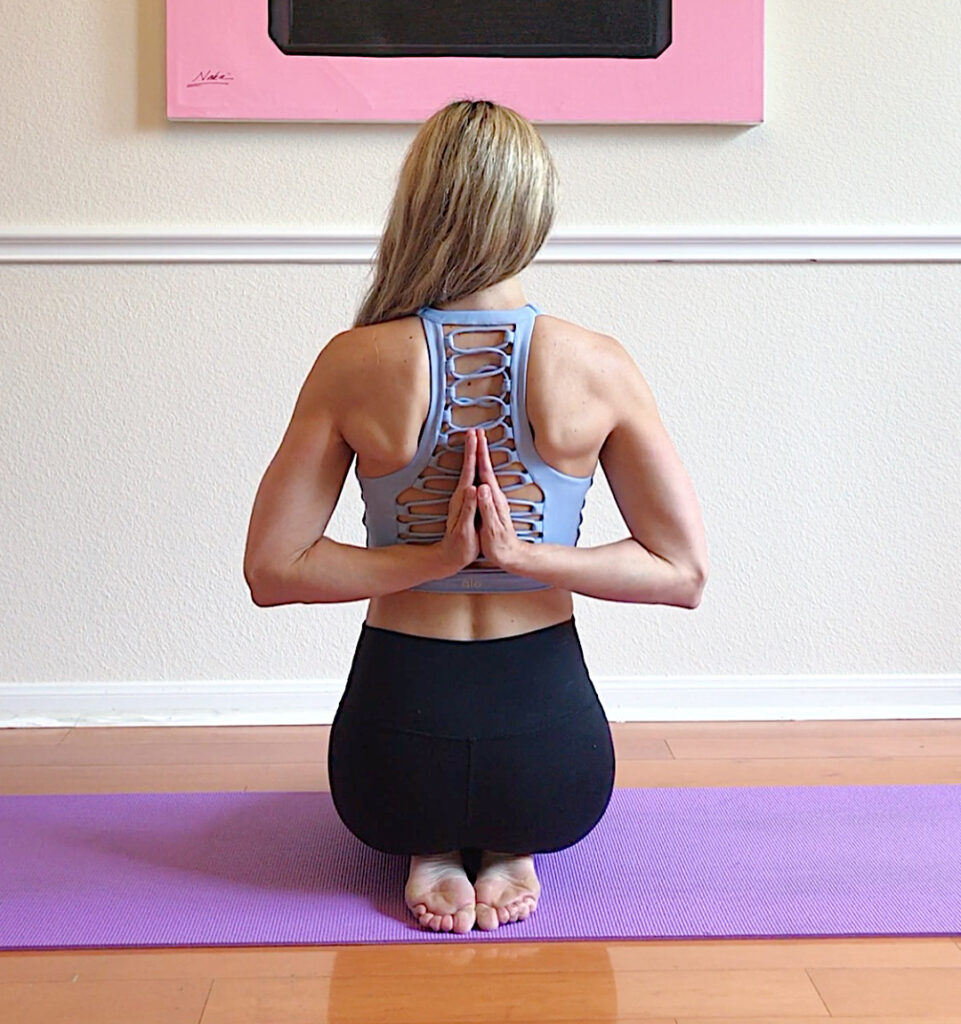
This yoga pose relief the pain and also increase flexibility and strength in your arms, chest and shoulder just by working towards Hands Clasped Behind the Back (Modify Poses with Reverse Prayer Hands)!
How to do:
- Sit in a Sukhasana or Vajrasana and bend your knees slightly.
- Relax your shoulders, bring your hands behind your back and hold the opposite elbow in opposite hands. Take 5 deep breaths. If you think this is enough for your body here! If you want to go to full Reverse Prayer Hands.
- Gently mix your palms together in prayer posture and keep your fingers down.
- When you inhale, slowly bend your fingers towards your spine, until they face you.
- Breathe in here and when you’re ready, slowly exit the way you came in.
3. Melting Heart Posture
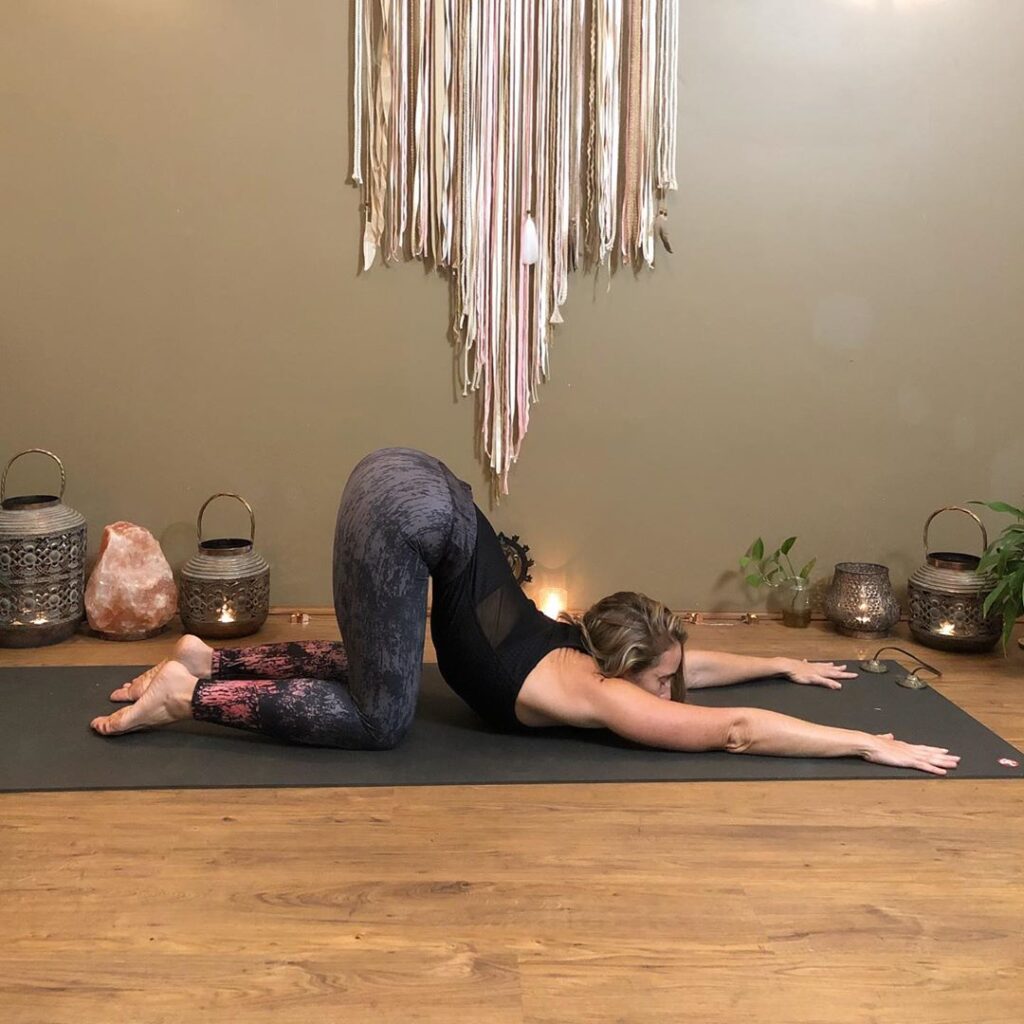
Melting Heart Posture helps to open the shoulder and upper back and this yoga pose also relieves pain. It creates space in the stomach and in the organs around the stomach. This yoga stimulates the meridian lines of the bladder in the back, bladder, kidney, heart, lungs, arms in your stomach and small intestine.
How to do:
- To get into this posture, start in the table pose on your hands and knees. If you already feel some pain in your knees, put a blanket under it.
- Turn the hands forward, ensuring that your hips stay just above the knees. Slowly sink your heart onto the mat, think of that melting heart.
- Stay in this posture for 3-5 minutes. To come out of the pose, bring your hips under your heel in a hair pose.
- Another option is to move your stomach towards the ground.
4. Balasana (Childs Pose)
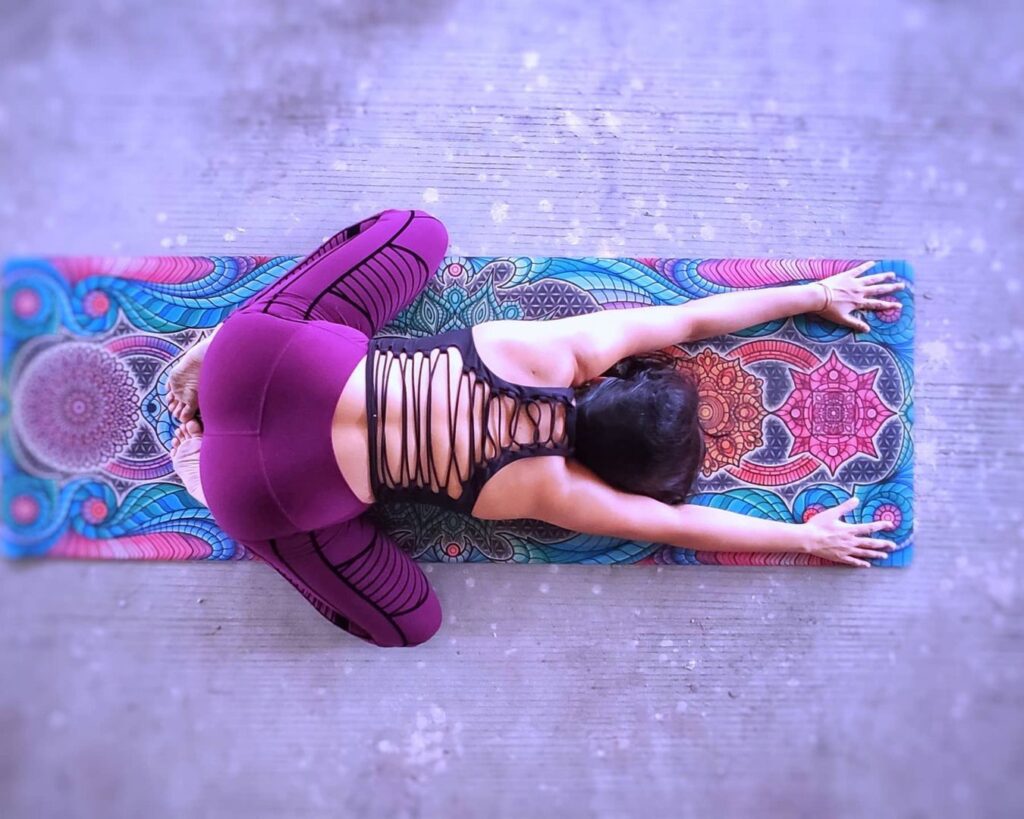
Balasana (Childs Pose) slowly extends the hips, thighs, ankles, calms the brain and helps relieve stress and fatigue. This yoga pose gives relief from back, neck and shoulder pain when walking with head and torso.
How to do:
- Kneel on the floor. Touch your big toes together and sit on heel, then spread knees as wide as your hips.
- Exhale and place torso between your thighs. Wider your pelvis to the back of your pelvis and narrow the point of hips towards the navel, so that they are rubbed downward to the thighs. When you raise the base of your skull from the back of your neck, lengthen your tailbone from behind the pelvis.
- Place your hands on the floor with your torso, palms, and drop the fronts of shoulders towards the floor. Feel how the weight of the front shoulders pulls the shoulder blades across your back.
- Balasana is a resting posture. Stay from 30 seconds to a few minutes. Beginners can use the glove to do a deep forward bend, where the torso rests on the thighs. Stay in the posture for 1 to 3 minutes.
- To come up, first lengthen your front torso, and then press down with the inhalation lift from the tailbone and into the pelvis.
5. Rabbit Pose
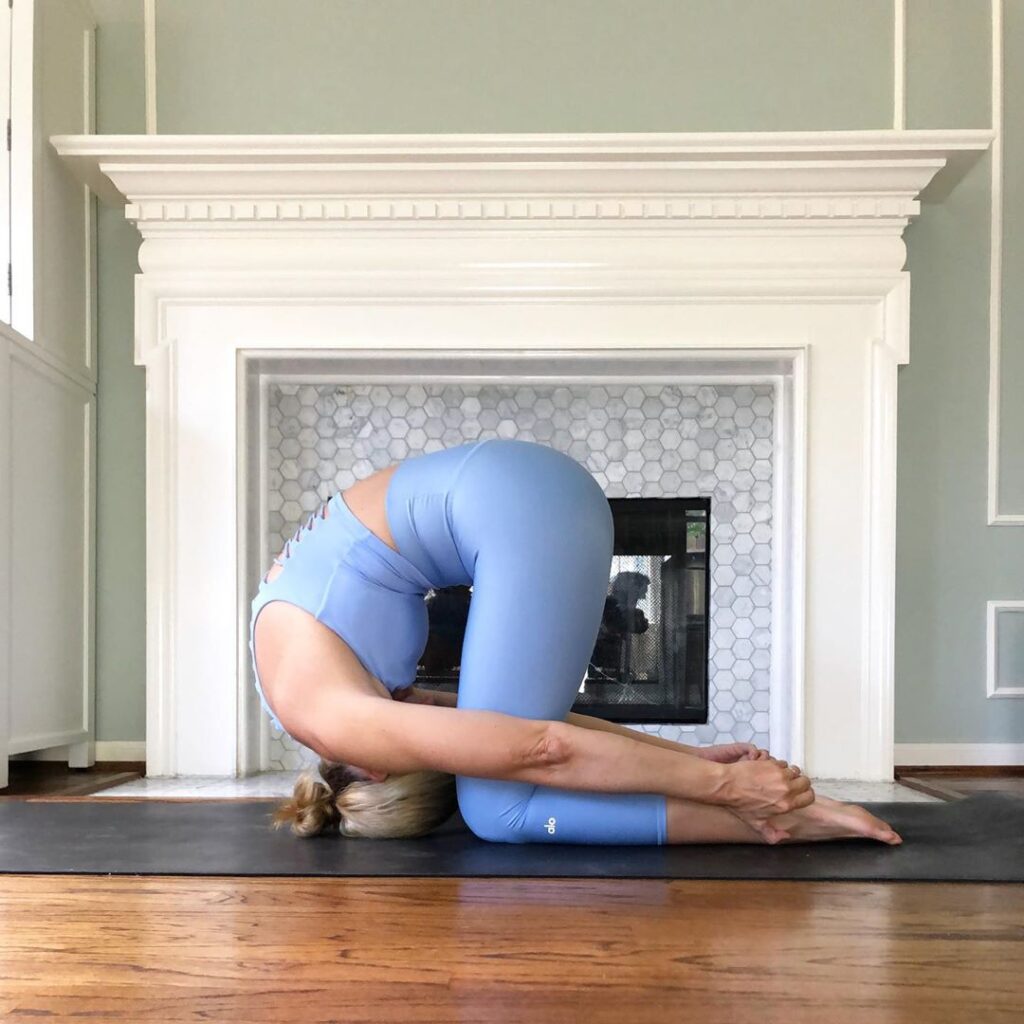
The Rabbit Pose or Shashankasana (śaśakā āsana) lengthens the spine and extends the back, hands, and shoulders, stimulating the immune and endocrine systems. This yoga pose is recommended for those have neck and shoulder pain and difficulty controlling anger or frustration.
How to do:
- With the child pose, grab the heel with your hands and pull the forehead from the top of the head to the knees on the floor.
- Hold the heels tightly, and raise the hips towards the ceiling. Roll on the crown of the head and press the forehead as close to the knees as possible.
- Breathe and hold for 4-8 breaths.
- To release: Exhale slowly and take the hips off the heels and slide the forehead from the floor to the hair posture.
6. Marjaryasana (Cat Pose) and Bitilasana (Cow Pose)

Flexing and extending the spine can help improve circulation in the disc in your back. This yoga yoga is a basic motion, but one that can be very beneficial in supporting the back and easing shoulder and back pain and maintaining a healthy spine, especially if spend a lot of time sitting.
Marjaryasana (Cat Pose) and Bitilasana (Cow Pose) can help you improve your posture and balance. It is considered a good stress-reliever and calm posture, as you combine movements with your breathing.
How to do:
- Start on your hands and knees in a table pose with a neutral pose. As you inhale and go into the cow’s pose, raise your sitting bones upward, push your chest forward and allow your stomach to sink.
- Raise your head, rest your shoulders away from your ears, and gaze straight ahead.
- When you exhale, come to the cat pose, rounding your spine outwards, tucking in your tailbone, and pulling your pubic bone forward.
- Drop your head towards the floor – just don’t put your chin on your chest. Most importantly, just relax.
7. Garudasana (Seated Eagle Arms)
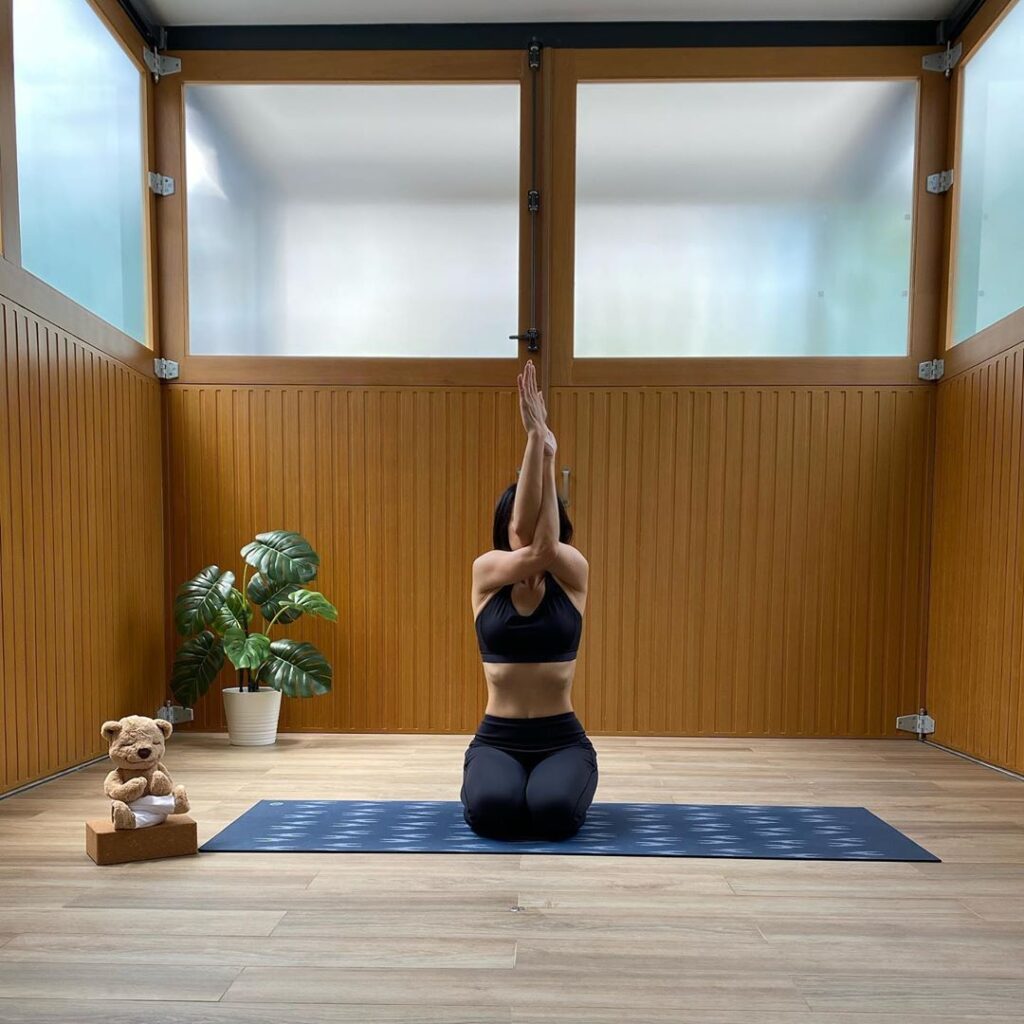
The Garudhasana (Seated Eagle Arms) is a good shoulder opener for those with stiff shoulders and extends the joints of the wrists, elbows and shoulders. This improves the posture of the upper trunk and straightens the spine and makes it stable. Garudhasana (Seated Eagle Arms) yoga pose removes pain from shoulder and lower neck area. It opens the shoulders and chest.
How to do:
- Sit in a comfortable position (Sukhasana or Vajrasana) on the floor with arms resting on the thighs. Sukhasana or easy posture can be eclipsed by sitting on the mat with the feet. If you have difficulty sitting on the floor, you can also do it by sitting in a chair.
- Bring both hands close to each other with elbows.
- Move the right hand around the left hand and touch the right palm with the left palm. At this point the two arms are inter-twisted simultaneously like two snakes.
- Keep the spine straight and relax the shoulders.
- Stare straight. Breathe normally in this last position.
- Keep in the position as long as you can.
- To relieve the position, un-twine the arms and bring the arms back to the thighs.
- A person can also practice by turning around the right hand with the left hand.
8. Thread the Needle

Its is the effectively release of the need back tension and detoxes the body naturally. Thread the Needle yoga pose relieves pain and tension between shoulder blades and stretch arm, chest and neck.
How to do:
- Start in a neutral tabletop position with your hands and knees on your mats.
- Exhale under your left hand to reach your right hand.
- Rest your right shoulder and ear on the ground.
- Keep weight equal to your knees, feet straight behind you.
- Hold for 5-10 breaths. Drop back to the table top, then repeat on the other side.
9. Easy Twist
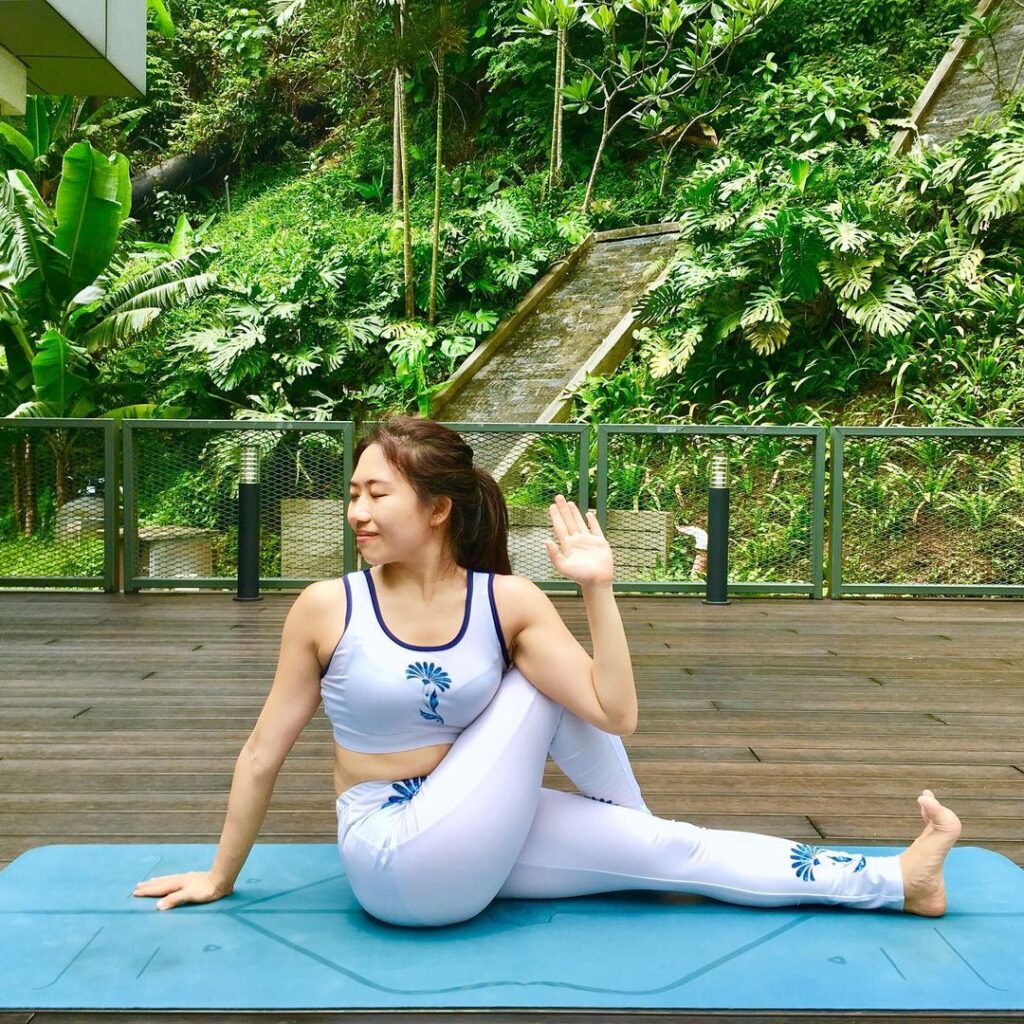
Easy Twist (Marichyasana C) yoga pose keeps spine healthy, opens your shoulder and ease pain. It stimulates and strengthens the muscles around the ribs and back, improves posture and breathing. Also performs abdominal massage that can help with digestion and elimination.
How to do:
- Start in Dandasana. Bend the right knee and place your foot away from your hip on a comfortable mat.
- Extend the ground and spine through both sitting bones.
- Keep your right hand or fingers behind you for support.
- As you exhale, raise your left hand up. Exhale and bend your upper back to the right.
- Bring your left hand over the right leg, press the left upper arm against the outer right knee. Bend the left elbow, point your fingers at the ceiling, and keep that arm active.
- With each inhalation, press the seated bones into the floor and lengthen the spine.
- With each exhale, see if you can turn slightly to the right.
- Keep the extroverted leg active.
- Stay for 5 deep breaths.
- To come out of the pose, bring your gaze to the front while exhaling and release your hands and straighten both legs while exhaling.
- Stop or take Vinesa before repeating on the other side.
10. Sphinx Pose

Sphinx Pose (Salamba Bhujangasana) is a gentle backbend suitable for most beginners. It lengthens the abdominal muscles, strengthens the spine, and tightens the buttocks. Pose also extends and opens the chest, lungs and shoulders. It stimulates the body, calms the nervous system, and is also therapeutic for fatigue.
How to do:
- Start by lying on the floor with your feet apart behind you, hip-width apart. Place your arms on your side and your chin on the mat. Push the top of your feet into the mat and spread your toes. Do not tuck your toes, as this may break your spine.
- Bring your arms up and rest your shoulders under shoulders with forearms on the floor, parallel to each other. Point your middle fingers straight ahead.
- On one breath, press your forearms into the floor and raise your head and chest above the floor. Push your pubic bone into the floor. Engage your feet vigorously. Roll your outer thighs slightly towards the floor to help lengthen your low back.
- Keep your elbows on your side. Drop your shoulder blades down your back and pull your chest forward. Extend your tailbone towards your heel.
- Make your face and eyes soft. Stretch your chin to the back of your neck. Gaze your “third eye,” the space between eyebrows.
- Hold for 10 breaths. To release, slowly move your torso, chest and head to the floor while exhaling. Relax your arms on your sides. Turn your head to the side and relax quietly.
11. Bhujangasana

Cobra Pose (Bhujangasana) increases spine mobility, strengthens spinal muscles, and this yoga pose can help relieve shoulder and back pain. It opens the chest and the anterior part of the body.
How to do:
- You can begin by lying on your stomach.
- Keep your palms straight under your shoulders on the ground. Bend your elbows straight back and hug them at your sides.
- Stop for a moment looking straight down at your mat with your neck in a neutral position. Anchor your pubic bone on the floor.
- Inhale to lift your chest from the floor. Roll your shoulders back and place your lower ribs on the floor. Make sure your elbows continue to hug your sides. Do not let them exit on both sides.
- Keep your neck neutral. Do not crank it. Your gaze should remain on the floor.
12. Locust (Salabhasana)
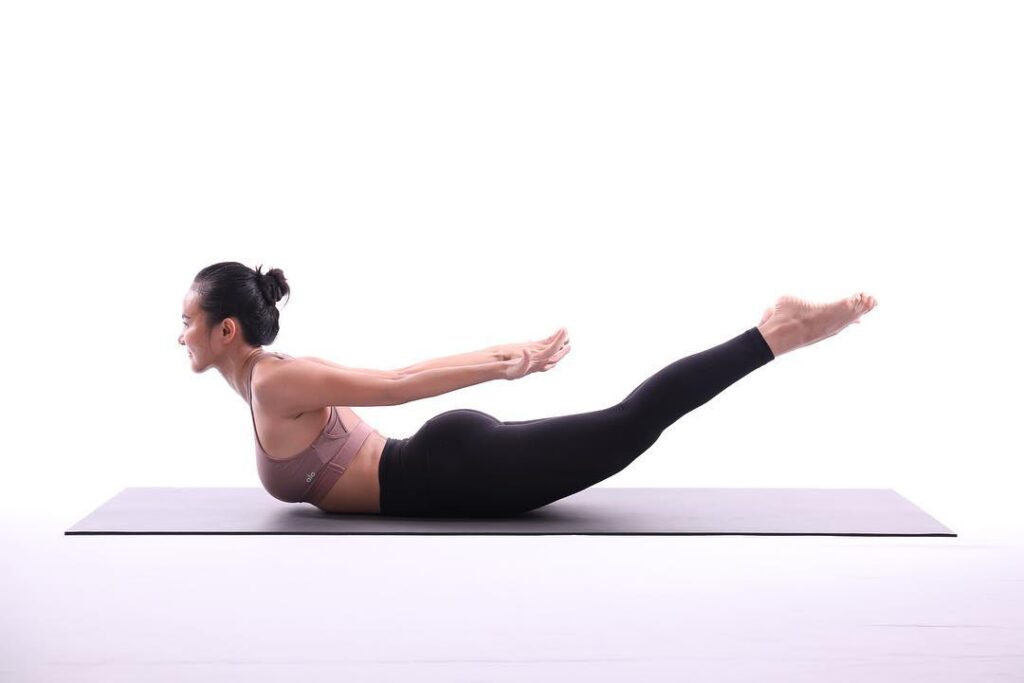
The Locust pose or salabhasana strengthens the muscles of your buttocks, spine and back of the arms and your legs. This yoga pose stretches your chest, shoulder, abdomen and thighs, enhances posture, helps relieve pain, relieve tension and stimulates abdominal organs.
How to do:
- For this pose, you may want to pad the floor under your pelvis and ribs with a folded blanket. Lie on your stomach with your arms at the side of torso, palms up, your forehead resting on the floor. Rotate your big toes towards each other and turn your thighs inward, and strengthen buttocks so that your coccyx presses towards your pubis.
- Exhale and lift your head, upper torso, arms and your legs off the floor. You will be resting on your lower ribs, abdomen, and front pelvis. Strengthen your buttocks and reach firmly through your feet, first through the heel to lengthen the back legs, then through the base of the big toes. Keep the big toes facing each other.
- Raise your arms parallel to the floor and actively pull back through your fingers. Imagine that there is a weight downwards behind the upper arms, and against this resistance raise it towards the ceiling. Push your scapula firmly into your back.
- Be careful not to bend forward and slightly upward, bend your chin forward and scrape the back of your neck. Keep the base of the skull and the back of the neck long.
- Stay 30 seconds to 1 minute, then exhale. Take a few breaths and repeat 1 or 2 times if you like.
13. Bridge Pose (Setu Bandhasana)
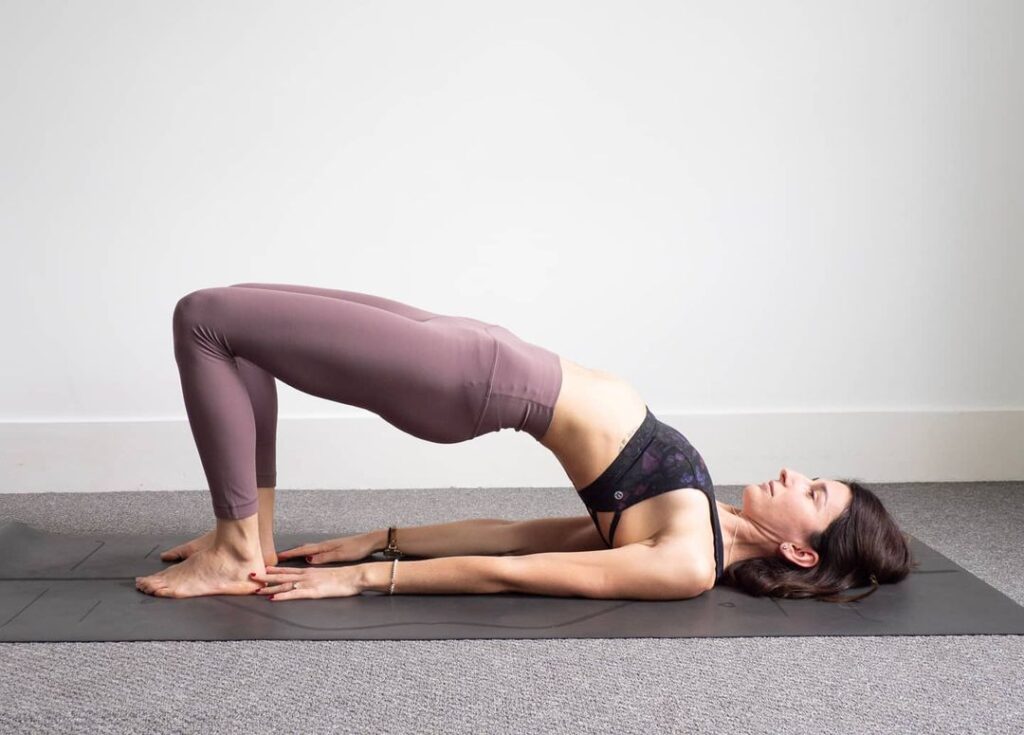
This yoga pose is excellent for shoulder and lower back pain, sciatica and stiffness of the ankle, hip, back, thighs and shoulders. It helps with fertility issues, helps improve lung capacity and helps during menstruation and pregnancy. The Bridge Pose also makes the muscles of the back strong.
How to do:
- Start by lying flat on your back. Then bend your knees keeping your feet shoulder-width apart. Extend your hands on the floor towards your feet. Your fingers should be able to touch your heel. Keep your neck relaxed.
- INHALE lifts its waist and extends the spine, raising its waist. Your knees and feet are strong and on the ground, and your knees should be above you. The weight should be distributed evenly between the shoulders and legs.
- EXHALE, Release your back and hip vertebrae by vertebrae. Repeat 8 to 10 times after your breath.
14. Uttanasana
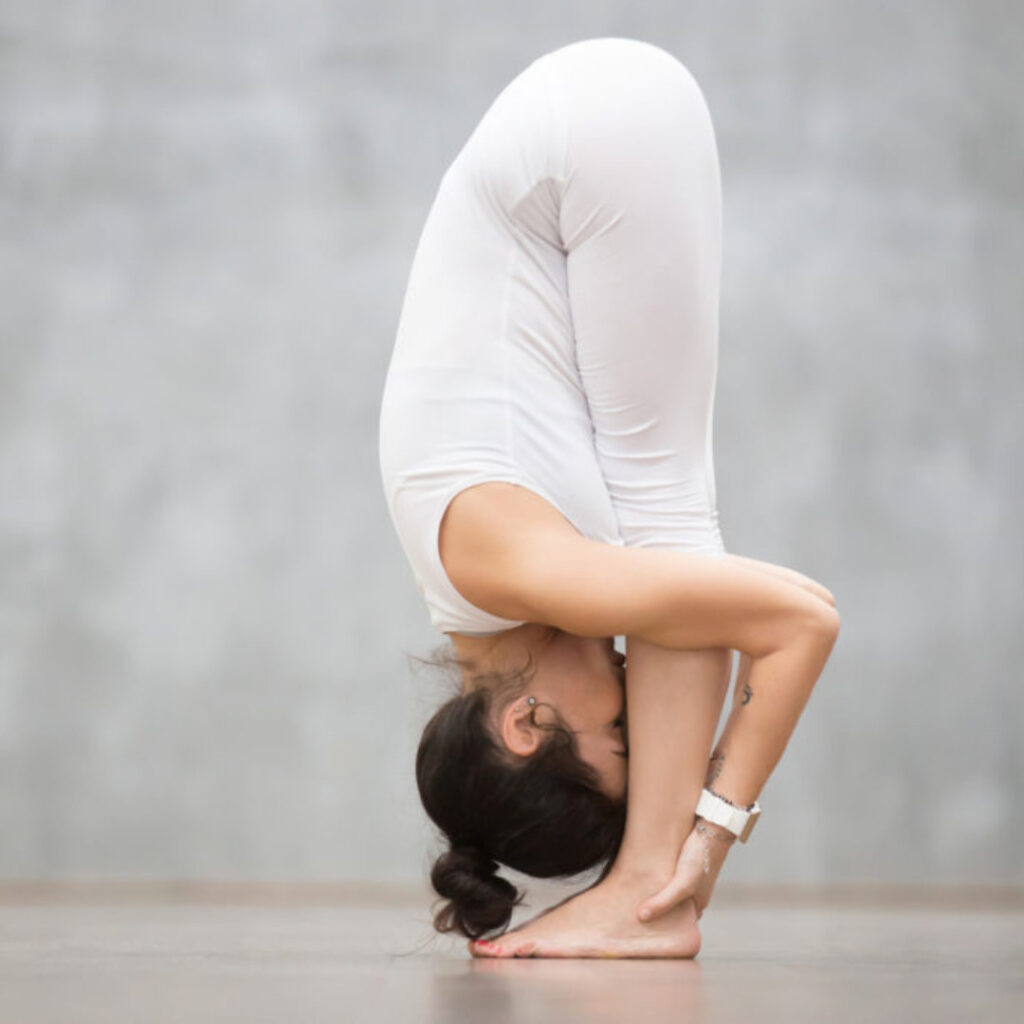
Stretches hips, hamstrings, calves and tightens thighs and knees. Keeps your spine strong and flexible. Reduces stress, anxiety, depression, fatigue and calms the mind and calms the nerves. This yoga relieves pain and tension in your spine, shoulder, neck , back and activates the abdominal muscles. It reduces the symptoms of menopause, asthma, headache and insomnia and stimulates the kidneys, liver, spleen, improves digestion and can reduce hypertension. Therapeutics for infertility, osteoporosis and sinusitis.
How to do:
- Start in tadasana/mountain pose.
- Inhale, raising your arms.
- When you exhale, engage your thighs, pull the stomach deeper and inward from the pelvic floor and lean forward from the hips.
- Place your hands / fingers on the floor, in front of your feet or next to your feet, or behind your ankles or calves.
- Place your hips on your heel as you press your heel to the floor. Roll your inner thighs slightly upwards.
- Hang your head while resting the neck.
- Lengthen your spine as you inhale. As you exhale, deepen the posture.
15. Prasarita Padottanasana (Wide Legged Forward Fold Pose)
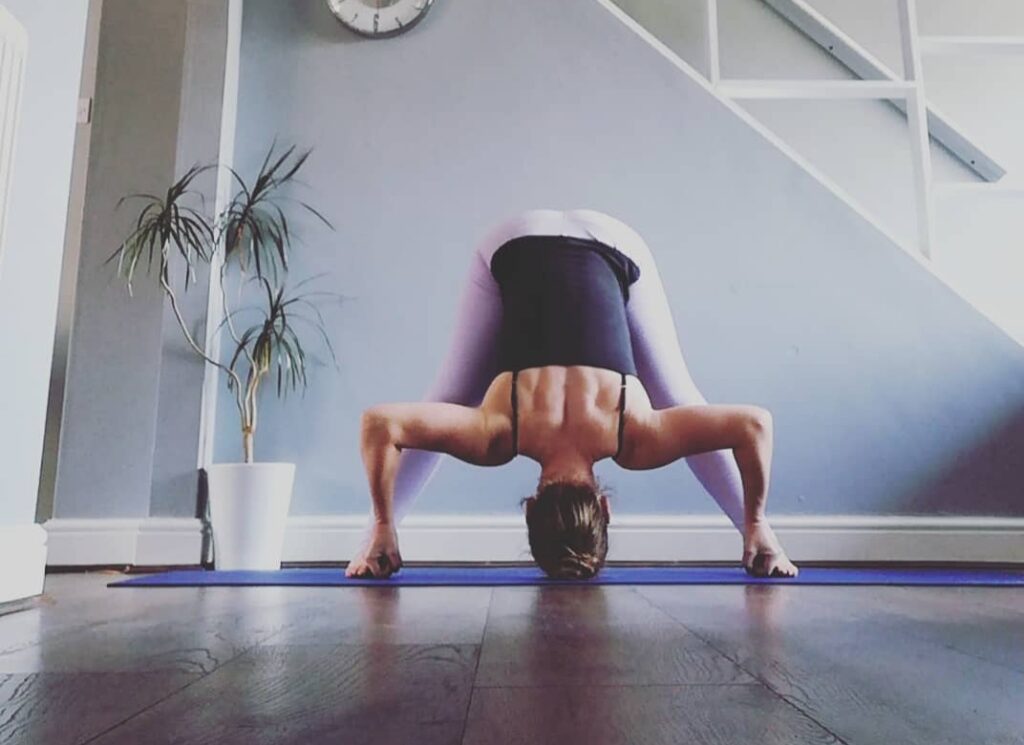
Prasarita Padottanasana (Wide Legged Forward Fold Pose) strengthens the hamstrings, calves, hips, lower back and spine. Different hand positions pull your shoulders, wrists, forearms and upper back.
This pose has the advantages of both forward folds and invasions:
- This yoga pose relief your back, neck and shoulder pain.
- It open hips, toned abdominal organs and improve digestion.
- Helps to calm mind, stress, anxiety and mild depression relief.
This pose also calms and calms the nervous system. Additionally, it helps prepare the body and mind for deeper yoga posture and introspection.
How to do:
- Stand facing the long side of your mat. Place your feet about 4 feet apart (this will vary slightly depending on your height) and place hands on hips. Look at your feet and check that your middle toes are facing the same direction.
- Raise your knees up to engage your thigh muscles. As you breathe, expand through your chest. As you exhale, start moving from your hip, keeping it in front of your torso for a long time.
- When you find your torso parallel to the floor, stop. Push your fingers on the floor, hands directly under the shoulders. Straighten your arms so that they are parallel to the floor like your feet.
- Keep the torso long and start moving your fingers back towards your feet so that they are between your legs. Bend your elbows and allow your torso and head to bend a full forward. If accessible, place the crown of your head between your feet on the floor.
- Use the palms of hands to press into the floor. If your body allows, continue to move your hands back, fingers forward, until your upper hands (triceps and biceps) are parallel with the mat. Allow the breath to widen your shoulder blades as you encourage them to lift your shoulders away from your ears.
- Hold this pose for 60 seconds. When you are ready to release, move your hands forward so that they are under your shoulders and your torso is once again parallel to the floor. Hands on hips, use a sigh to fully lift. Stand back.
16. Utthita Trikonasana
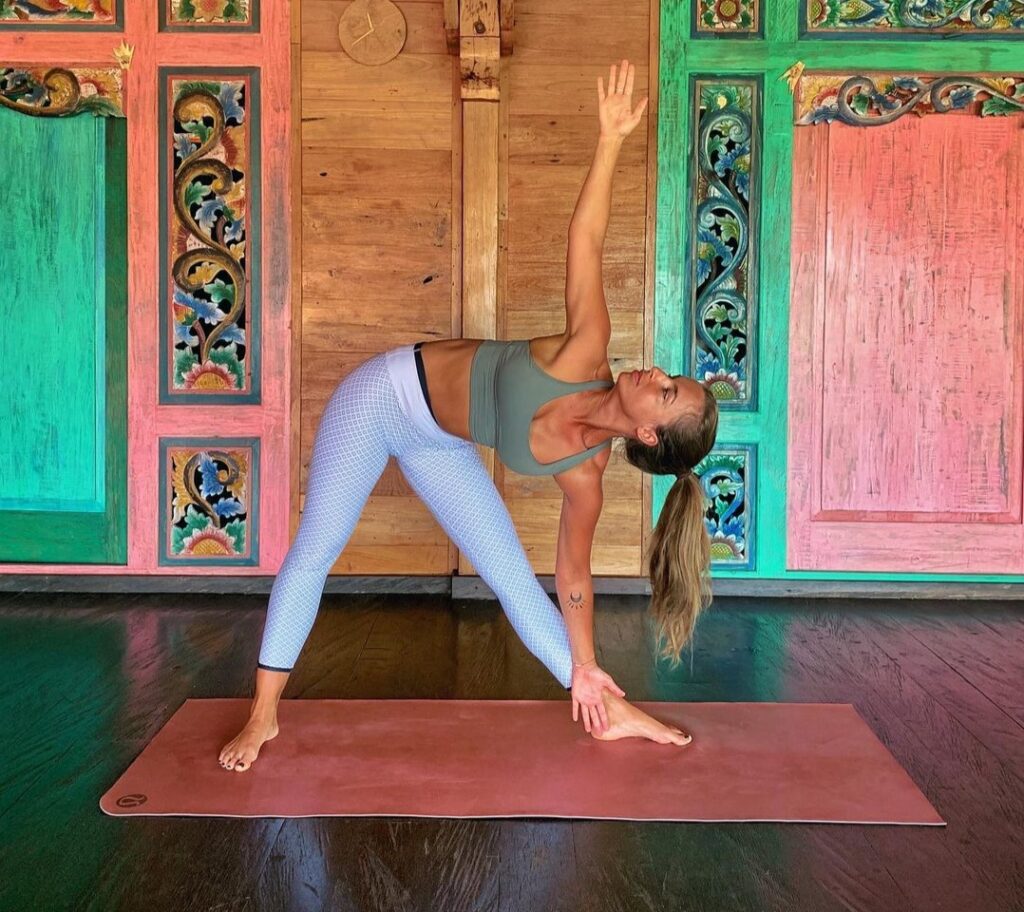
The Utthita Trikonasana strengthens your legs and extends your waist, hamstrings and hips and opens your chest and shoulders. It also challenges and improves balance and stability.
How to do:
- There are many ways to get into a Utthita Trikonasana. Entering from Warrior II works well because feet are already in the correct position. You do not need to widen or narrow your stance for this transition. So, from Warrior II, straighten your front leg (right leg in this case).
- Attach your right thigh muscle and pull your right femur into its socket. Extend your right hand towards the front of the room, tuck your right hip.
- Lower your right hand over your calf or ankle. If you are more open, bring your right hand to the floor or right foot. Do whatever feels most comfortable.
- There is a stack on the right above the left shoulder as you open your chest, keeping your left shoulder in its socket and reaching your fingers towards the ceiling.
- Turn your head to gaze at your left fingers. If it is uncomfortable for your neck, then it is also fine to keep the head in a more neutral position.
- Continue pulling your right thigh muscles upward, deepening the crease in your right hip.
- Slightly soften your right knee to prevent hypertension (this is called microbend).
- Hold for at least 5 breaths.
- Repeat the pose forward with your left leg.
17. Adho Mukha Svanasana (Downward Facing Dog)
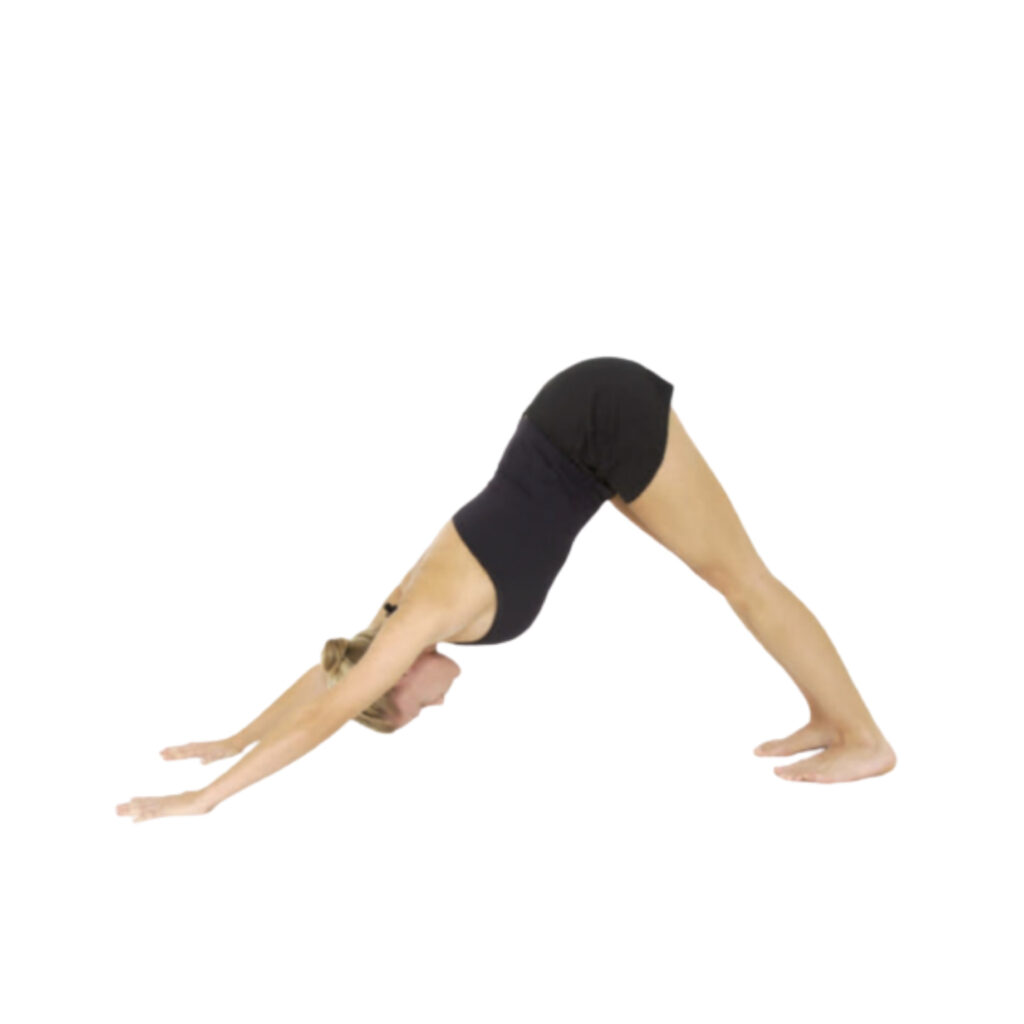
The Adho Mukha Svanasana (Downward Facing Dog) stretches the hamstrings and calves and strengthens the arms, legs and back. This yoga pose can help you relieve shoulder and back pain. As a mild reversal, it acts opposite to the normal forces on spine and brings more blood flow to your brain. The pose also strengthens the deep abdominal muscles which helps you to stabilize your spine.
How to do:
- Stand on four limbs, as if your body forms a table-like structure.
- Exhale and slowly raise your hips and straighten your elbows and knees. You need to make sure that your body is a reverted V-form.
- Your hands correspond to your shoulders, and your feet correspond to your hips. Make sure your toes point outward.
- Now, press hands into the ground and lengthen your neck. Your ears should touch your inner arms, and you should bend your navel towards your navel.
- Hold for a few seconds, and then, bend knees and return to the table position.
18. Revolved Side Angle
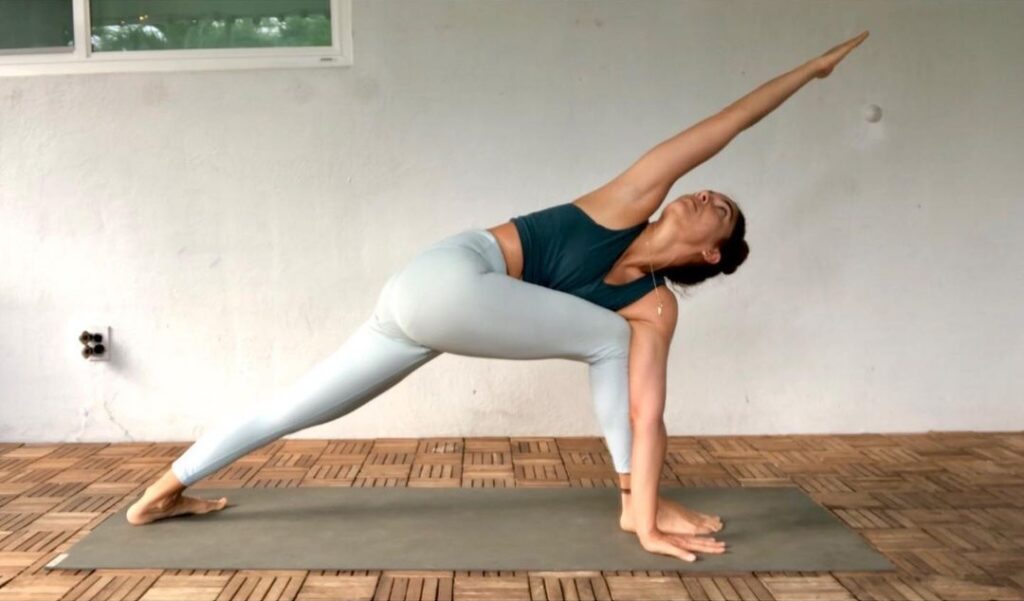
This pose strengthens and stretches the legs, hips, hamstrings and even the lungs. It also opens the chest and shoulders. Revolved Side Angle pose is traditionally believed to help stimulate and purify your organs and promote good circulation and range of motion. Many people find that this yoga pose help relieve stress and they can also find help reduce back and shoulder pain.
How to do:
- From the downward facing dog pose, bring your left leg forward inward with your left hand. Your fingers should be consistent with your fingers.
- Your foot should be bent at a 90 degree angle parallel to the floor. The knee is placed above the heel and the foot is forward.
- Pivot the ball of your right foot to drop the soles of your right foot to the floor.
- Place your right hand on the outside of your left leg, allowing your right shoulder to rest on the outside of your left knee. If possible, allow your hand to lie flat on the ground with the heel of the hand aligned with the heel of the left foot.
- Pull your belly button towards your belly as you bend your torso towards your left knee, opening the chest and stacking the right shoulder above the left shoulder.
- Raise your left arm towards the ceiling. Bring your gaze to the left hand.
- Stay in a twist for three to five breaths. Step downwards to the back of the dog and then raise the right leg forward.
19. Makarasana (Dolphin)
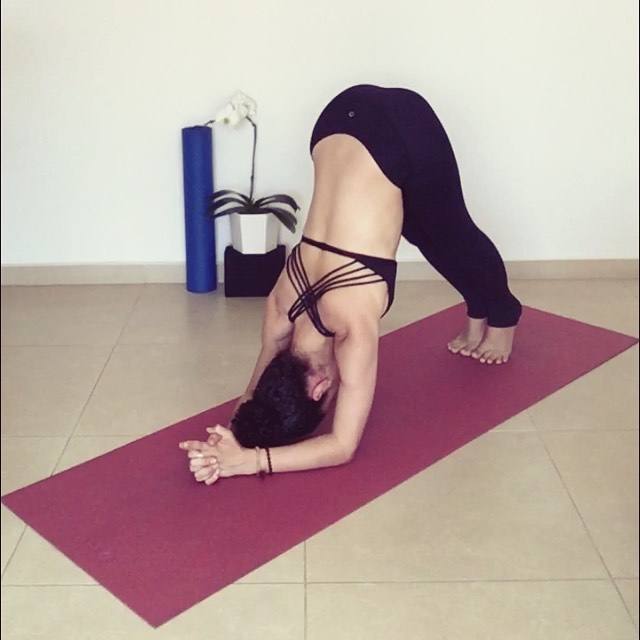
Makarasana (Dolphin) strengthens arms and shoulders and opens shoulders and chest. This yoga pose is believed to reduce neck, shoulder and back pain. Opens the back of the legs and feet. It is beneficial for people suffering from sciatica, high blood pressure, asthma and flat feet, along with calming the brain and reducing headaches, stress and mild depression.
How to do:
- Come on all four, align the shoulders on the hands and the hips on the knees.
- Keeping the arms parallel to each other, keeping them shoulder-width apart, one at a time gently hinge the ground on the ground. Press your palms and your forearms firmly into the mat.
- Exhale and curl under your toes, then start raising your hips towards the sky. Keep the knees slightly bent at first, lengthen your spine, pull the tailbone away from the pelvis, and soften your chest. Then engage your core and extend the legs.
- Keep pressing the forearms down and steady your shoulder blades against your back. Look a little forward and down between your arms.
- Stay here for 30 seconds to a minute. To release, exhale with your knees to the ground.
20. Sukhasana Parivrtti
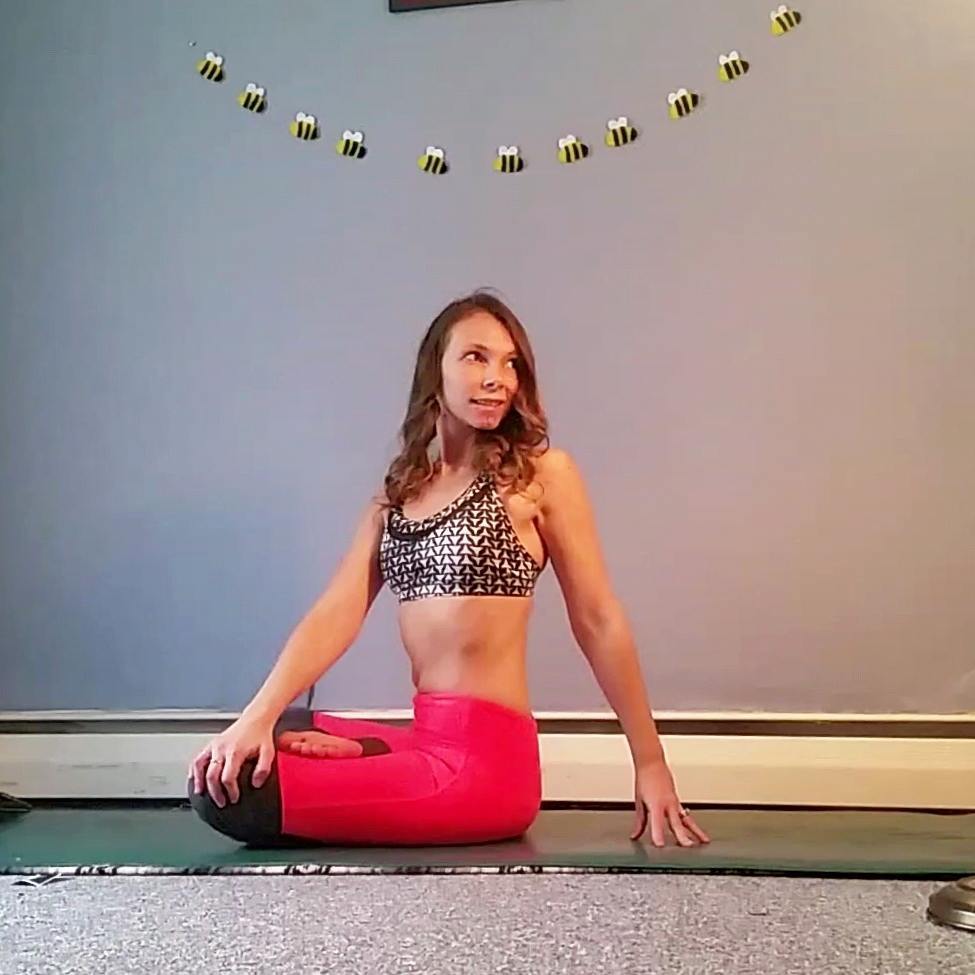
Sukhasana Parivrtti is one of the basic sitting postures. It helps to open the hips and shoulders. Helps increase flexibility of upper back and spine. Stretches the upper chest, hips, neck and shoulders. It is a great stress reliever. This yoga pose massage of abdominal organs, stimulates the liver and kidneys, lengthens the torso and spine, activates the spine.
How to do:
- Sit with your legs crossed and keep your spine straight. Place your left hand on your right knee, and place your right hand behind you on the ground, with the right hand externally rotated and the fingers pointing away from your sacrum.
- While exhaling, turn your head to the right while turning your head in the same direction. Stay here and breathe. While exhaling the next breath, keep turning your head right while turning your head right. On one breath, extend your spine vertically, spasming quite a bit.
- With each subsequent exhalation, gently lean your head towards the left shoulder, pulling forward to the right of the neck. Continue 8 breaths in total, then repeat on the other side.
21. Seated Forward Bend
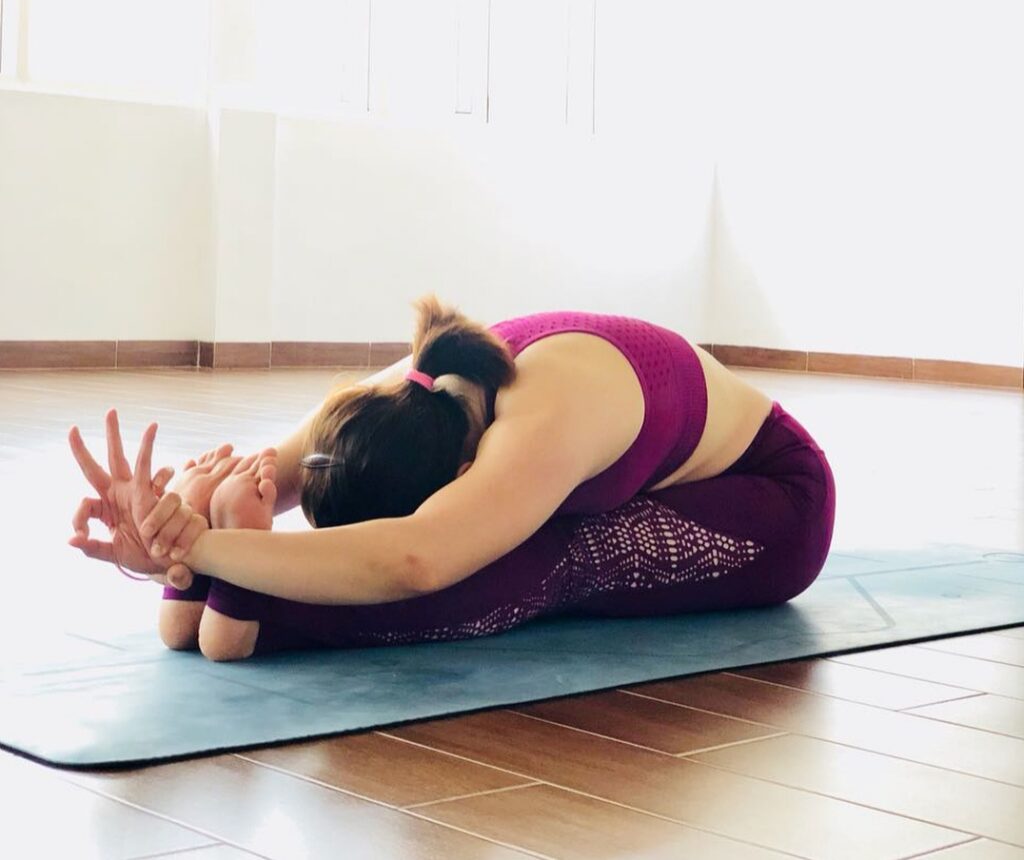
The Seated Forward Bend provides a deep stretch from the heel to the neck across the entire back of the body. This yoga pose calms your nervous system and emotions and stimulates the reproductive and urinary system.
How to do:
- Start sitting in the staff pose (dandasana), with both legs spread straight in front of you, the spine long. Actively press your heel into the ground and flex your feet.
- Inhale to extend your arms upward and sit tall, through the sitting bones, raising through the crown of the head.
- When you exhale, hinge on your hips to bend forward on your feet, maintaining a sense of length along your spine. Lead with your heart and hold your hands to whatever is accessible while keeping a flat upper back:
- calves,
- ankles,
- perhaps even the outer edges of your feet.
- Avoid the tendency to rear your chest and round your spine in an effort to move deeper into your fold. Keep your shoulders back and rest away from your ears, widen the collarbone, and reach your sternum towards your toes.
- With each inhalation, you find greater length along your spine and front body; With each exhale, go deeper into the fold ahead of you.
- Stay in the posture anywhere between 5 to 20 deep breaths. On one breath, slowly make your way to an upright position.
22. Apanasana

- Main purpose/objective: To stretch the posterior structures of the body, especially in the lower back.
- Secondary purpose/objective: To practice progressive abdominal contraction upon exhalation.
How to do:
- Start lying on your back. Bend your knees one at a time and place your hands on knees. Keep your arms extended.
- Exhale: Slowly contract your stomach and pull your thighs towards your chest.
- Inhale: Remove thighs, straighten arms.
- Take 4-6 breaths like this.
- TRICK: Don’t overdo your hands. Use your abdomen to initiate Sarvangasana and use your arms to complete it.
23. Savasana
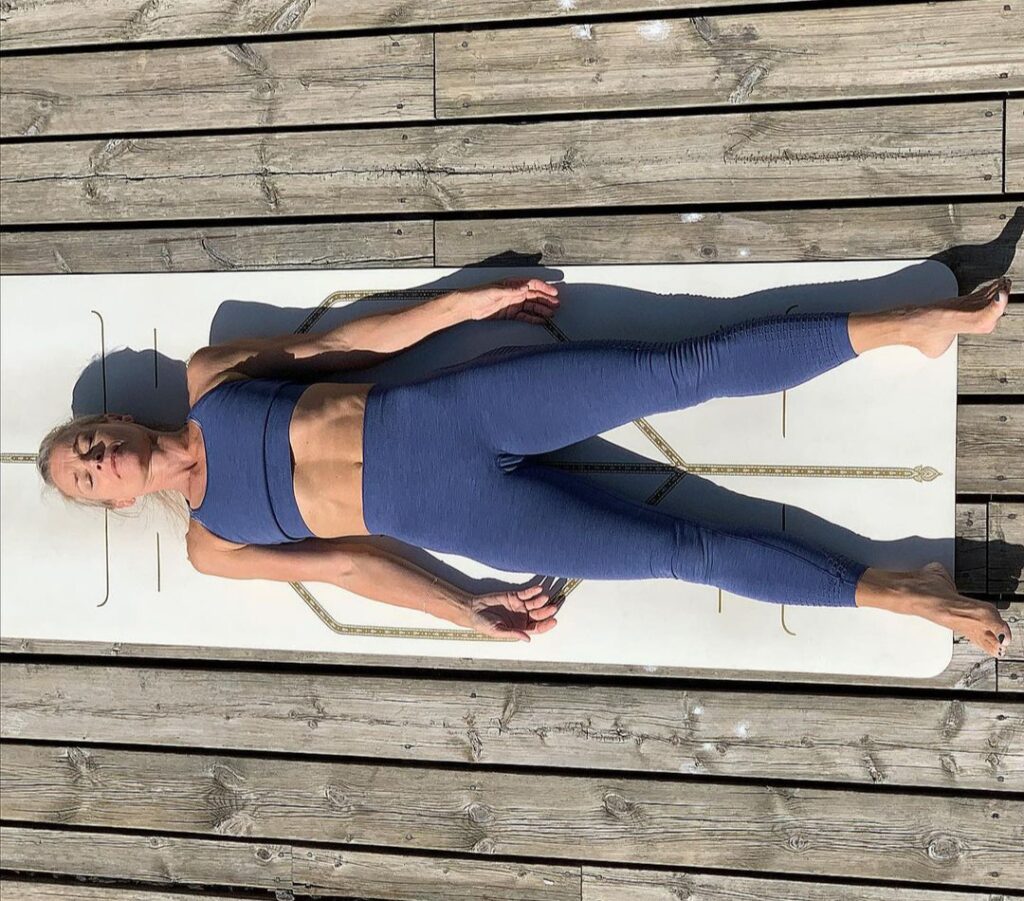
In meditation, sensory stimulation and external distraction are ultimately minimized to help the body fully relax. With a frozen body, mental energy can be transmitted inward and the mind can begin to explore the body from the inside.
Practice will increase body awareness and contradiction. Ingestion is an insight on the physiological state of the body and is associated with autonomic nervous system and autonomic motor control. The autonomic nervous system is normally in control of unconscious and automated bodily functions such as:
- breathing,
- heartbeat,
- digestive processes.
Savasana is often the concluding and final posture in practice, and is a wonderful time to channel the inward energy to restore and revive the hardworking mind and body.
While the asana flow helps to relax the body, it is time to reap all the benefits of physical practice.
Muscle and skeletal tension are deliberately relaxed in this posture. In a prolonged breath, the surface tightness is removed and exposes deeper layers of muscle tension.
How to do:
- Lie flat on your back with your arms relaxed, on your sides, palms up and legs slightly apart.
- Close eyes and allow your body to relax completely. Keep your mind relaxed and alert to the sensations in your body.
- Rest here for at least 3 to 5 minutes.
- Mitchell C, Adebajo A, Hay E, Carr A. “Shoulder pain: diagnosis and management in primary care.” BMJ. 2005 Nov 12;331(7525):1124-8. doi: 10.1136/bmj.331.7525.1124. PMID: 16282408; PMCID: PMC1283277.[↩]
- InformedHealth.org [Internet]. Cologne, Germany: Institute for Quality and Efficiency in Health Care (IQWiG); 2006-. “Shoulder pain: Overview.” 2020 Feb 13. Available from: https://www.ncbi.nlm.nih.gov/books/NBK554693.[↩]


